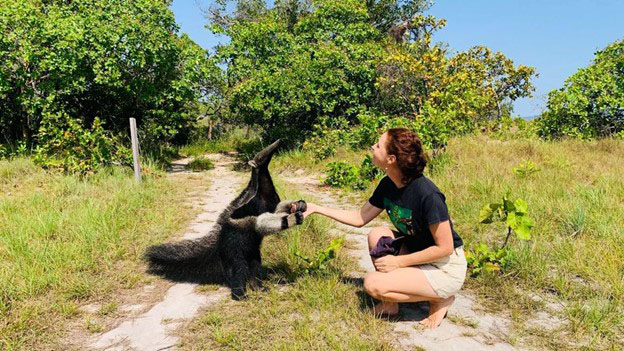In celebration of World Giant Anteater Day, observed last Tuesday, the South Rupununi Conservation Society (SRCS) placed the spotlight on Ulysses, a young giant anteater that was rescued earlier this year by a concerned Rupununi resident.
According to SRCS, the resident had called its representatives to take the baby in and it has been doing well since.
The SRCS said the giant anteater (Myrmecophaga tridactyla) is one of the most fascinating creatures of the Rupununi. They are known for their long snouts, impressive claws, and insatiable appetite for ants and termites. These gentle giants are a symbol of the unique biodiversity the society is dedicated to protecting, it stated.
The villages of Katoonarib, Sawariwau, and Shulinab, SRCS said, are leading the way in giant anteater conservation by designating their lands as safe zones. These efforts ensure a secure habitat for this iconic species
“In the Rupununi, giant anteaters play a vital role in the ecosystem, helping to control insect populations and contributing to the health of our grasslands,” it added in a post on its Facebook page.
However, sadly, the anteaters face threats like habitat loss, uncontrolled fire, and road collisions. The SRCS called for all to work together to protect these gentle giants and the habitats they call home. According to https://www.earth.com World Anteater Day is celebrated on November 19th annually and aims to raise awareness about the unique lives of anteaters and the conservation challenges they face.
This day highlights the importance of protecting anteaters and their habitats, particularly as their survival is threatened by habitat destruction, illegal wildlife trade, and road collisions.
According to the website, when it comes to the health and balance of the ecosystems they inhabit, anteaters play a crucial role through their specialised diet and behaviour.
“By consuming large quantities of ants and termites, they regulate the populations of these insects, preventing them from becoming overly abundant and causing ecological imbalances,” it added.
This natural pest control, it added, helps protect vegetation and soil from the damage that excessive insect activity can cause, such as defoliation and soil degradation.
In their search for food, anteaters often disturb the ground, aerating the soil and promoting nutrient cycling. This activity creates microhabitats that benefit other organisms, including plants and smaller animals, by improving soil quality and fostering biodiversity.
Anteaters also serve as prey for larger predators, making them an integral part of the food web. Their presence is a sign of a healthy ecosystem, highlighting their importance in conserving biodiversity and maintaining environmental stability.
